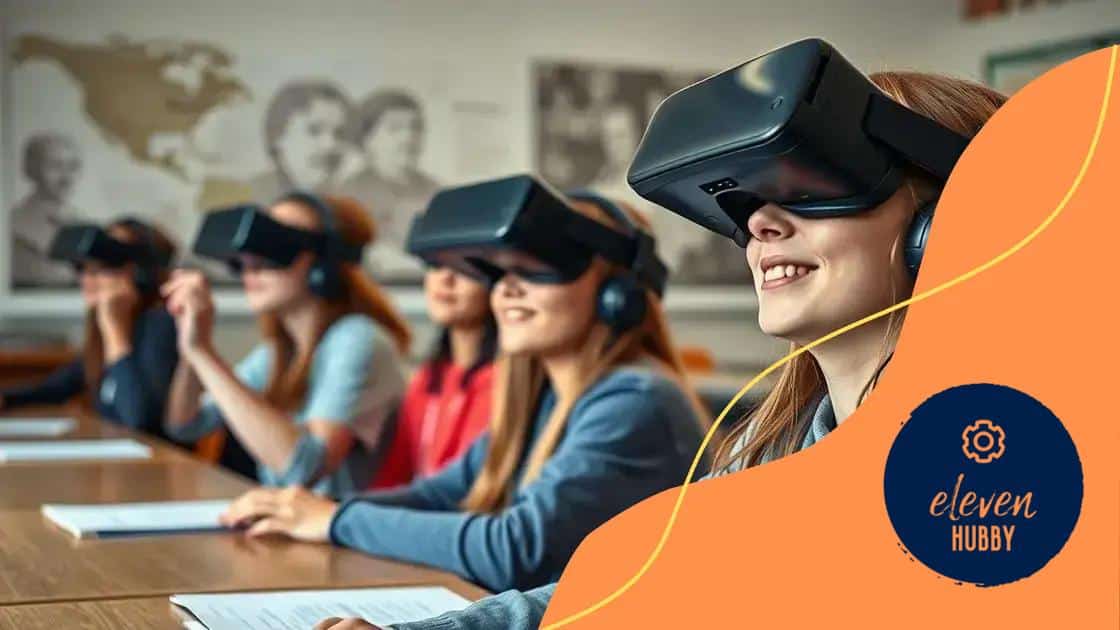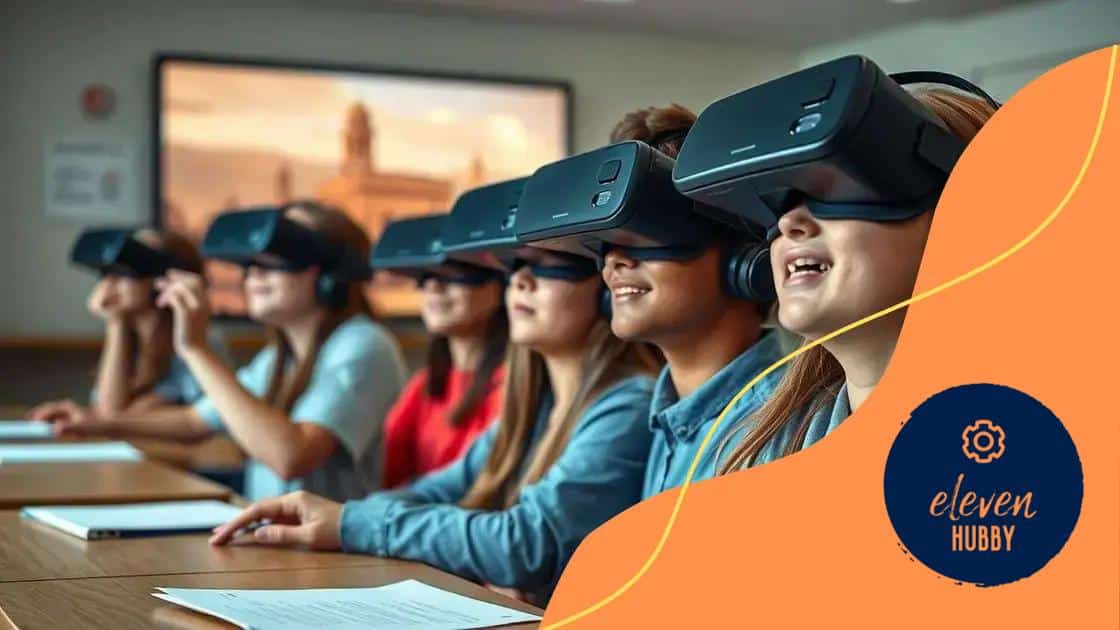Virtual reality’s role in history education

Virtual reality’s role in history education enhances student engagement and understanding by creating immersive experiences, although challenges like cost and technical issues remain significant barriers to widespread adoption.
Virtual reality’s role in history education is reshaping how we teach and learn about the past. Imagine stepping into ancient civilizations and experiencing history firsthand. Curious about how this works? Let’s dive in!
Understanding the basics of virtual reality
Understanding the basics of virtual reality is crucial for grasping its impact on education. Virtual reality (VR) allows users to immerse themselves in a simulated environment. This technology changes how students feel about history, making it more engaging and memorable.
VR creates realistic educational experiences. When students wear a VR headset, they can explore historic sites or events as if they were actually there. Imagine walking through ancient Rome or standing on the battlefield of Gettysburg! This technology opens up countless opportunities for learning.
Key Components of Virtual Reality
To fully appreciate how VR works, it helps to understand its main components:
- Headset: A device worn on the head that displays the virtual environment.
- Controllers: Handheld devices that allow users to interact with the virtual space.
- Software: Applications that create and manage the virtual environments.
These components work together to create an immersive experience. As technology improves, these experiences grow more realistic and accessible.
The Benefits of Virtual Reality in Education
VR also offers several benefits in the classroom. First, it enhances engagement; students are more likely to participate when they can experience history firsthand. Additionally, VR enables personalized learning. Everyone can explore at their own pace, which is especially helpful for different learning styles.
Moreover, VR promotes collaborative learning. Students can work together in virtual environments, developing teamwork skills important for the future.
The use of VR in education is not just a trend; it is reshaping how history is taught. As more teachers adopt this technology, students will gain a deeper understanding of historical events.
Engaging students through immersive experiences
Engaging students through immersive experiences is one of the most exciting aspects of virtual reality in education. By stepping into a virtual world, students can experience lessons in a way that traditional methods cannot achieve. When students are part of the action, they are far more likely to retain the information.
A major advantage of immersive experiences is that they can make learning fun. Imagine a history class where students virtually visit the pyramids of Egypt or watch the signing of the Declaration of Independence. These experiences not only bring events to life but also foster a deeper connection to the material.
How Immersive Experiences Boost Engagement
There are several ways immersive experiences engage students:
- Active participation: Students become part of the story, enhancing their connection to the subject.
- Visual learning: Seeing historical events unfold allows students to understand context better.
- Emotional connection: Experiencing events through VR helps students develop empathy for historical figures or situations.
These factors combine to create a rich learning environment where curiosity thrives. As students explore different time periods and places, they engage with history on a personal level.
Another important element is collaboration. Many VR experiences allow students to work together in virtual environments. This teamwork not only makes learning more enjoyable but also helps students improve their communication and social skills.
Let’s consider a virtual field trip where students can explore the ancient ruins of Rome. As they navigate through the city, they can see architecture and artifacts in real-time. Such experiences give students a unique perspective that they cannot access through textbooks or videos alone. Engaging students in this manner creates lasting memories that reinforce what they learn.
Case studies: Successful VR implementations in history

Case studies: Successful VR implementations in history show the transformative power of virtual reality in education. These real-life examples illustrate how VR can make history come alive, helping students engage with the past in exciting ways. Many schools and institutions have found that VR leads to stronger retention of information and a deeper understanding of historical events.
One impressive case study is the Roman Colosseum project. In this initiative, students use VR headsets to explore ancient Rome as it once was. They navigate the bustling streets and the grand arenas while learning about the culture, architecture, and historical events that took place in this iconic city. Through immersive storytelling, students gain insight that traditional textbooks cannot provide.
Notable Examples of VR in History Education
Several projects highlight the successful integration of VR technology in history classes:
- The Anne Frank House VR experience: This project allows students to tour Anne Frank’s hidden annex in Amsterdam, learning about her life during World War II.
- Wonders of the World: Schools have utilized VR to visit UNESCO sites like the Great Wall of China, providing students with a visual context for their studies.
- Virtual Time Travel: Programs that let students experience pivotal moments, such as the signing of the Treaty of Paris or major historical battles, creating real-time engagement.
These implementations emphasize how VR bridges gaps in understanding. For example, students can interact with artifacts in a 3D space, allowing them to analyze and appreciate the significance of objects they might only see in pictures.
Furthermore, educators report increased enthusiasm and participation from their students when using VR. Lessons become more dynamic, sparking curiosity and encouraging further exploration of complex topics within history.
As educators continue to explore new ways to leverage technology, these case studies serve as compelling evidence of the benefits of virtual reality in the classroom. Schools investing in VR are not just keeping up with technology; they are enriching students’ learning experiences and making history more relatable and engaging.
Future trends of VR in educational settings
Future trends of VR in educational settings promise exciting changes for how we learn. As technology evolves, so does the potential for virtual reality to transform classrooms everywhere. Educators are starting to see the immense benefits of using VR, urging schools to explore these groundbreaking tools.
One key trend is the increasing affordability of VR technology. More schools are finding it feasible to implement VR experiences without breaking the budget. As companies create more accessible headsets and educational content, the barriers to entry continue to fall. This means that students from diverse backgrounds will have access to enhanced learning experiences.
Integration of VR with AI Technologies
Another promising trend is the integration of artificial intelligence with VR. This combination can create adaptive learning environments tailored to the needs of individual students. For example, AI can analyze how students interact with VR content and adjust the difficulty of tasks based on their performance.
- Personalized learning paths: AI can help craft unique learning experiences for each student.
- Real-time feedback: Instant assessment of students’ understanding can greatly improve learning outcomes.
- Dynamic content generation: Learning materials can be adjusted based on student interests and performance.
These innovations are set to make learning more engaging and effective. Teachers can utilize data from VR experiences to refine their instruction methods, ensuring they address the varied needs of their students.
Collaboration and Community through VR
Future VR applications may further enhance collaboration among students. With more schools adopting VR, geographic boundaries can blur, enabling students to learn side by side with peers from around the world. Collaborative projects, discussions, and shared experiences in virtual environments can foster global connections that enrich students’ understanding of different cultures.
VR can also serve as a powerful tool for teacher training. Educators can practice classroom management or engage in simulated scenarios to build confidence and skills. By immersing themselves in various teaching situations, teachers will be better prepared for real-world challenges.
The future of VR in education holds vast potential. As technology advances, we can anticipate more innovative applications that make learning more exciting and efficient. Engaging students in history through immersive experiences is just the beginning of what VR can achieve.
Challenges and limitations of using VR in classrooms
Challenges and limitations of using VR in classrooms are important factors to consider as schools embrace this new technology. While virtual reality offers many benefits, it also presents obstacles that educators must navigate. Understanding these challenges can help schools implement VR more effectively.
One major challenge is the cost. Although VR technology has become more affordable, many schools still struggle with budget constraints. The initial investment for headsets, software, and necessary infrastructure can be significant. Schools with limited funding may find it difficult to incorporate VR into their curriculum.
Technical Limitations
Another challenge is the technical requirements of VR. Setting up VR systems can be complicated. Not all classrooms have the required space, equipment, or reliable internet connection for smooth VR experiences. Technical failures during class can disrupt lessons and frustrate students and teachers alike.
- Training for teachers: Educators need proper training to use VR tools effectively. Without this support, teachers may struggle to integrate VR into their lesson plans.
- Content availability: While many VR educational resources exist, there are still areas where quality content is lacking. Schools may find it challenging to find suitable VR experiences for their specific history topics.
- Physical comfort: Some students may experience discomfort while using VR headsets, such as motion sickness or eye strain. This can make VR unsuitable for every learner.
As schools consider adopting VR, they need to be aware of how these limitations can impact learning. Communication with students and parents about the challenges of VR is essential to manage expectations and build support.
Classroom Management Issues
Additionally, VR can create classroom management challenges. When students are immersed in a virtual world, it may be challenging for teachers to monitor their behavior. Keeping students engaged and focused during VR activities requires new strategies and methods of oversight.
While VR presents innovative opportunities for learning, understanding its limitations is vital for successful implementation. Educators must balance the excitement of VR technology with practical concerns to ensure that students receive the best educational experience possible.
FAQ – Frequently Asked Questions about Virtual Reality in History Education
What are the main benefits of using VR in history classes?
VR makes history lessons more engaging and interactive, allowing students to experience historical events in an immersive way.
What challenges do schools face when implementing VR technology?
Schools may struggle with costs, technical requirements, and the need for teacher training to effectively integrate VR into their curriculum.
Can all students use VR comfortably?
Some students may experience discomfort, such as motion sickness or eye strain, while using VR. It’s essential to monitor their reactions and adjust accordingly.
How can VR enhance collaboration among students?
VR allows students to work together in virtual environments, promoting teamwork and connections with peers globally, enriching their learning experience.






